Abstract
Although previous national surveys have shown an increase in the use of complementary and alternative medicine (CAM) in the U.S. population, racial and ethnic minority populations were under-represented in these surveys. As a result, a profile of the CAM user as white, female, affluent, middle-aged and well educated has emerged. Representing the mainstream population, these previous studies did not take into account the racial and ethnic minority populations who may have their own healing traditions and who may hold different beliefs, use different terminology, and have unique patterns of CAM use. In partnership with community-based organizations and community residents, a culturally sensitive survey instrument and protocols were designed and tested to gather data on lower income, urban African-Americans' use of, attitudes toward, and understanding of CAM. The major findings of this pilot research are 1.) Community-partnered research can help researchers gain access to sensitive data and design culturally appropriate studies; 2.) CAM terminology varies by cultural group; 3.) Certain forms of CAM (folk or family practices) are commonly found in African-American populations; and 4.) Factors that affect CAM use--including age, lack of access to conventional medicine, cultural heritage, and dissatisfaction with conventional medicine.
Full text
PDF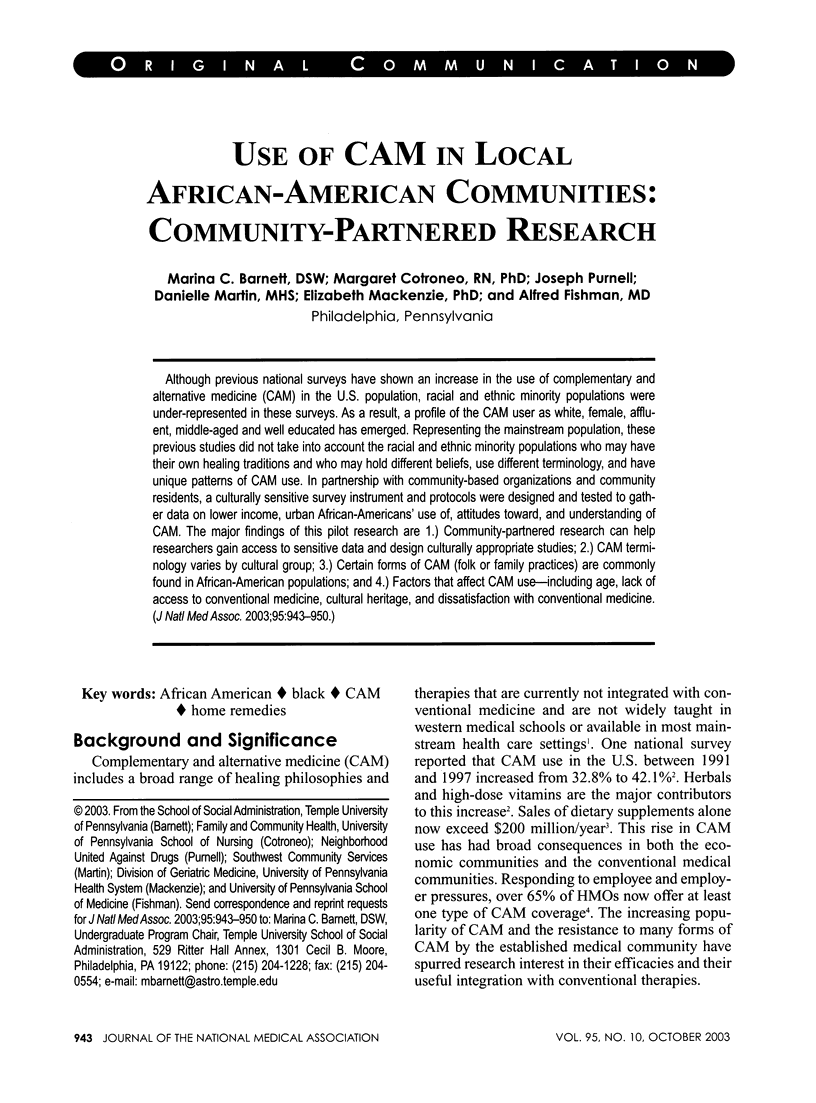
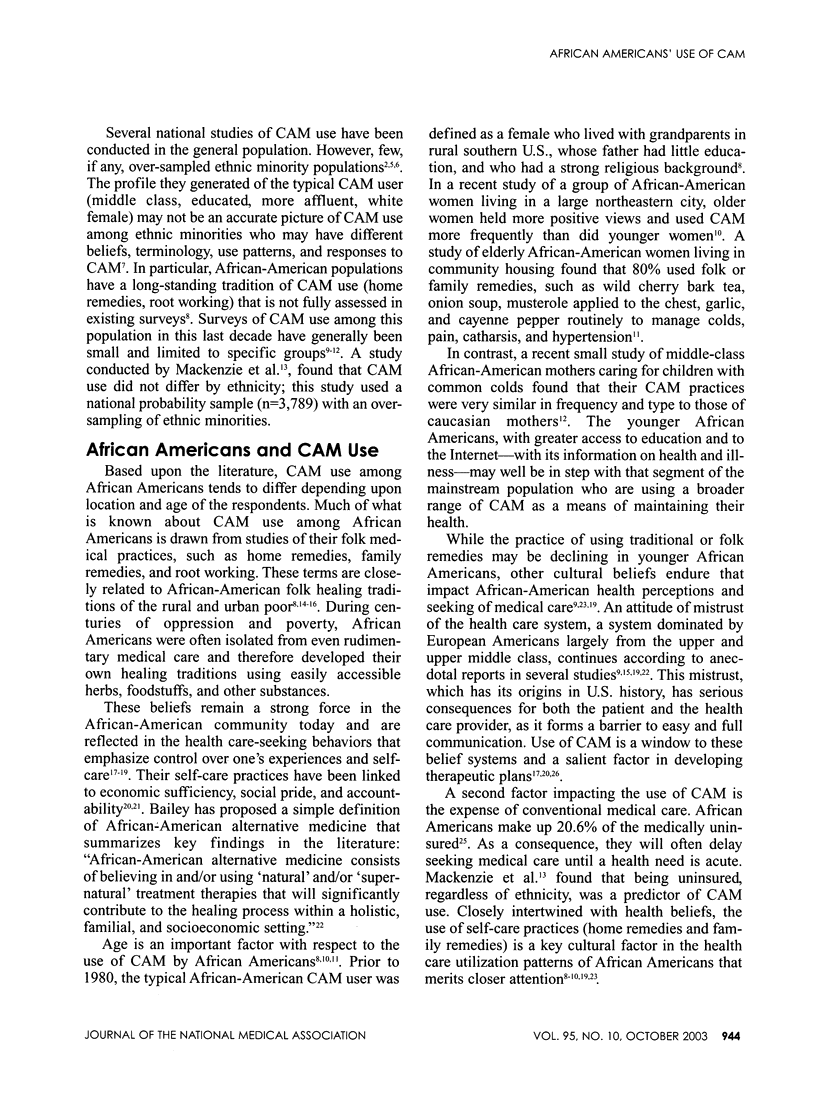
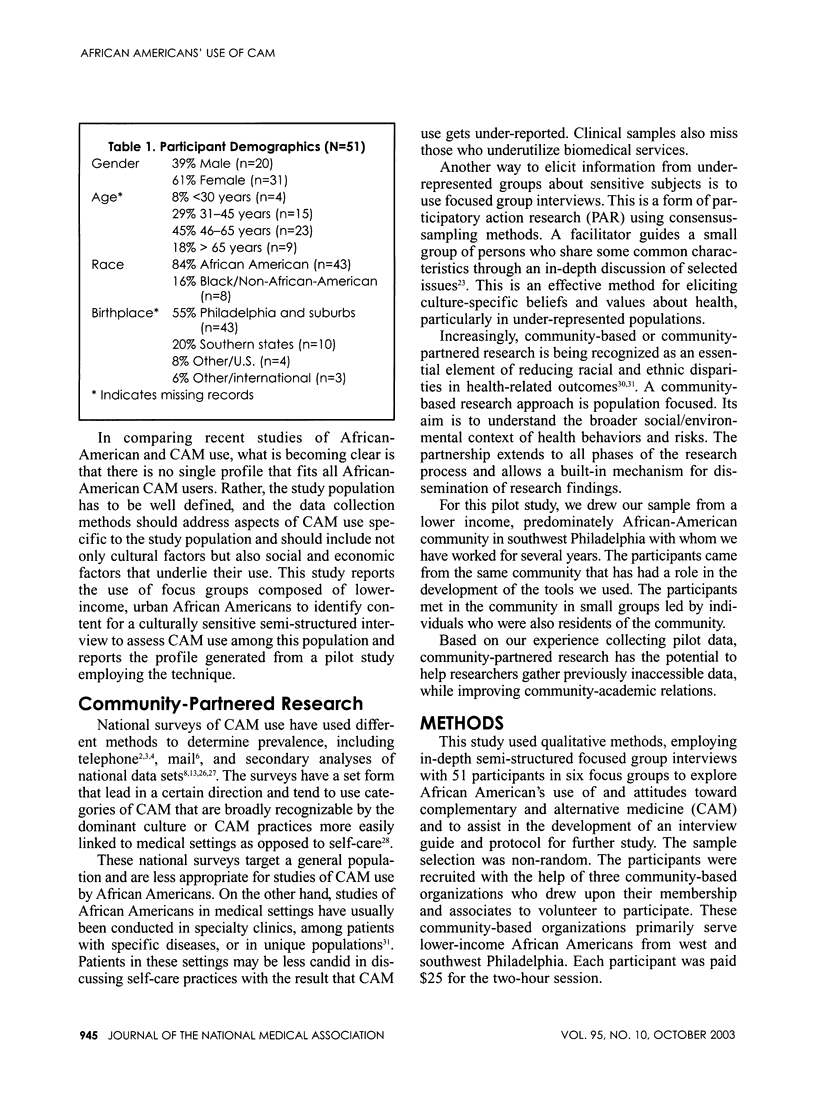

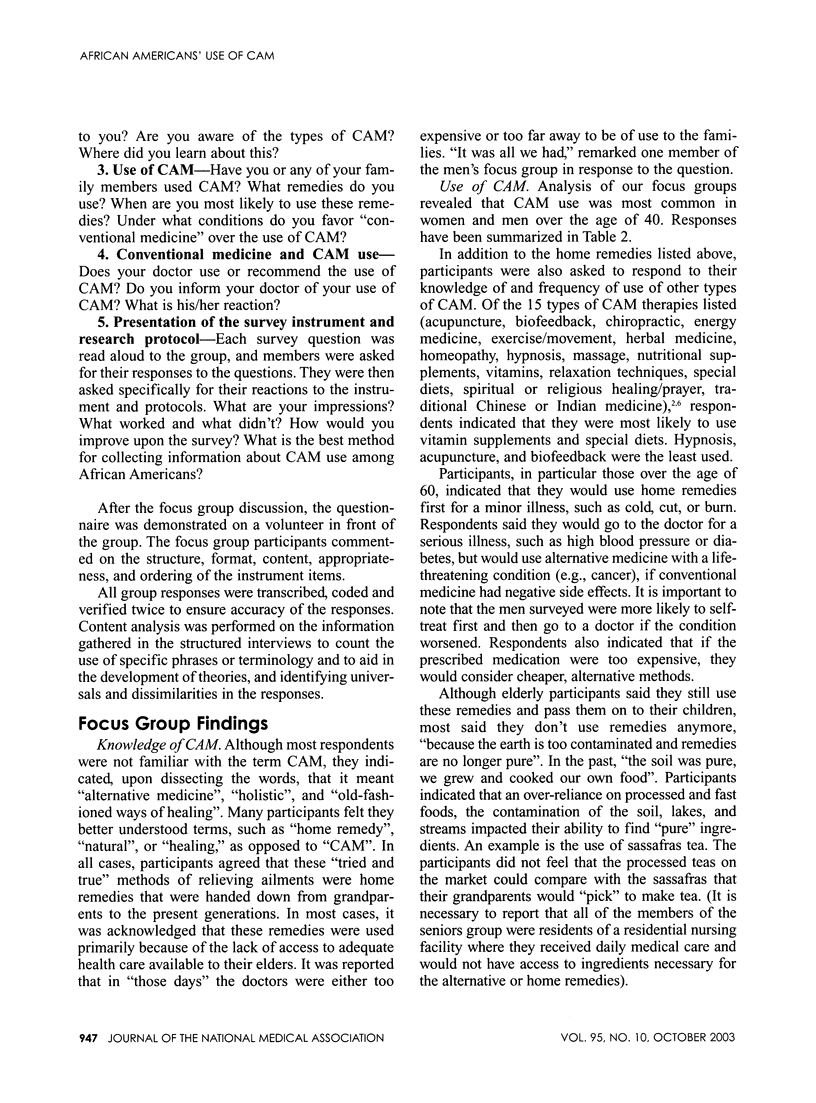
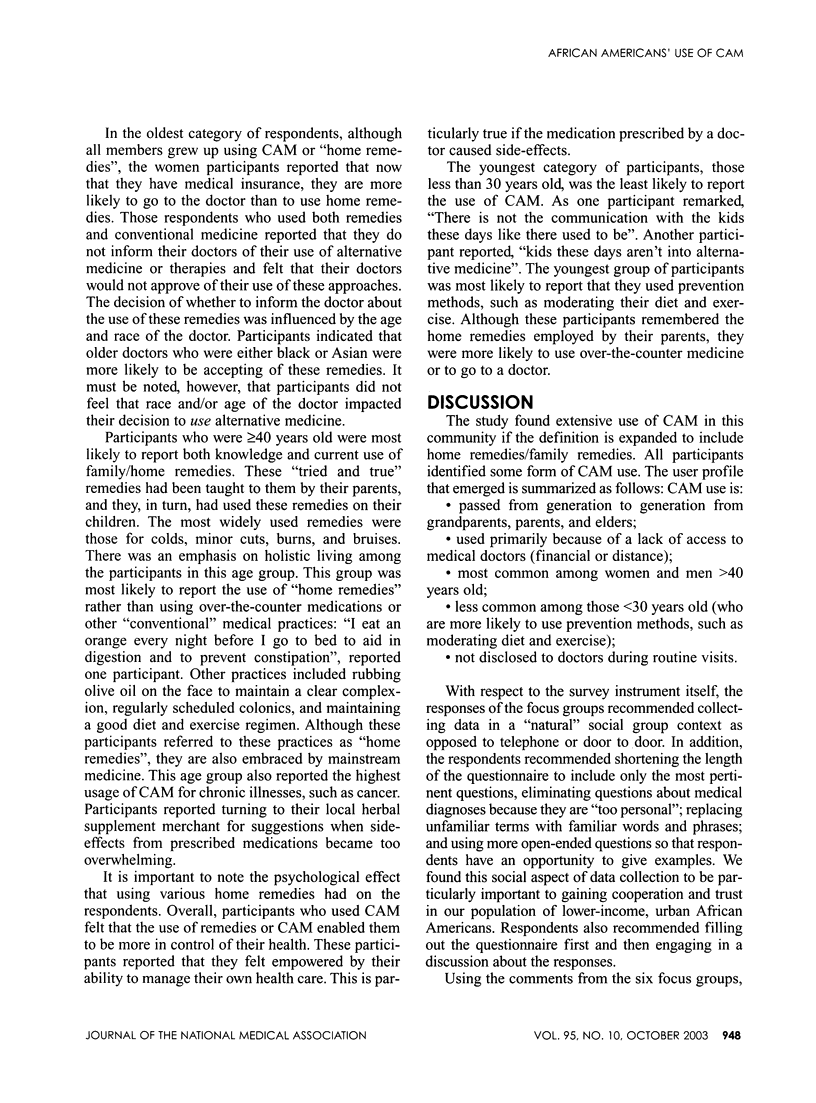
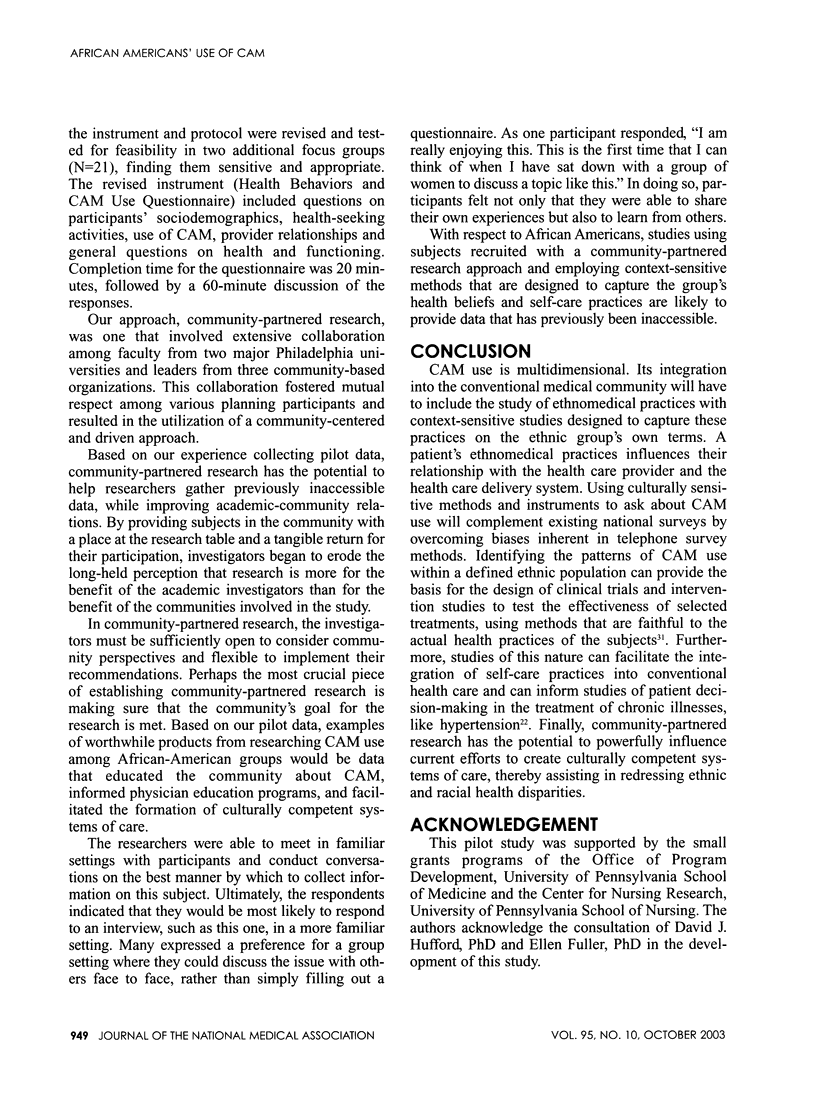
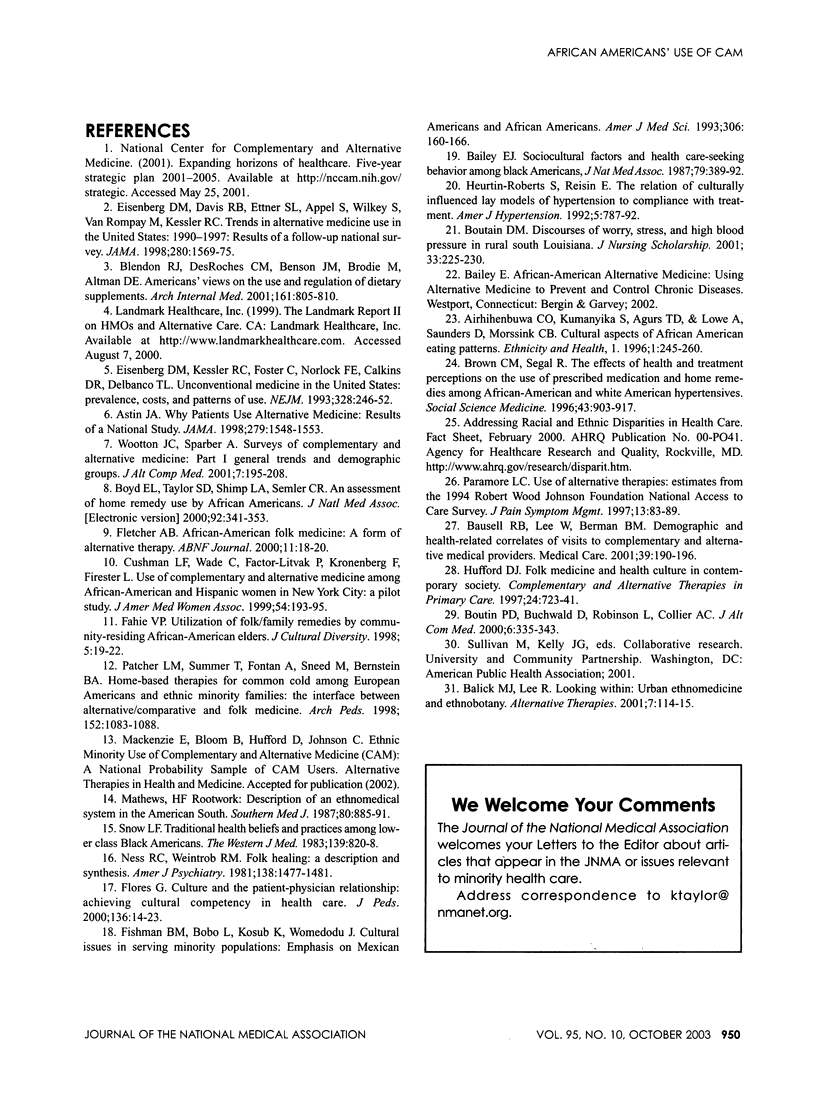
Selected References
These references are in PubMed. This may not be the complete list of references from this article.
- Airhihenbuwa C. O., Kumanyika S., Agurs T. D., Lowe A., Saunders D., Morssink C. B. Cultural aspects of African American eating patterns. Ethn Health. 1996 Sep;1(3):245–260. doi: 10.1080/13557858.1996.9961793. [DOI] [PubMed] [Google Scholar]
- Astin J. A. Why patients use alternative medicine: results of a national study. JAMA. 1998 May 20;279(19):1548–1553. doi: 10.1001/jama.279.19.1548. [DOI] [PubMed] [Google Scholar]
- Bailey E. J. Sociocultural factors and health care-seeking behavior among black Americans. J Natl Med Assoc. 1987 Apr;79(4):389–392. [PMC free article] [PubMed] [Google Scholar]
- Balick M. J., Lee R. Looking within: urban ethnomedicine and ethnobotany. Altern Ther Health Med. 2001 Jul-Aug;7(4):114–115. [PubMed] [Google Scholar]
- Bausell R. B., Lee W. L., Berman B. M. Demographic and health-related correlates to visits to complementary and alternative medical providers. Med Care. 2001 Feb;39(2):190–196. doi: 10.1097/00005650-200102000-00009. [DOI] [PubMed] [Google Scholar]
- Blendon R. J., DesRoches C. M., Benson J. M., Brodie M., Altman D. E. Americans' views on the use and regulation of dietary supplements. Arch Intern Med. 2001 Mar 26;161(6):805–810. doi: 10.1001/archinte.161.6.805. [DOI] [PubMed] [Google Scholar]
- Boutain D. M. Discourses of worry, stress, and high blood pressure in rural south Louisiana. J Nurs Scholarsh. 2001;33(3):225–230. doi: 10.1111/j.1547-5069.2001.00225.x. [DOI] [PubMed] [Google Scholar]
- Boutin P. D., Buchwald D., Robinson L., Collier A. C. Use of and attitudes about alternative and complementary therapies among outpatients and physicians at a municipal hospital. J Altern Complement Med. 2000 Aug;6(4):335–343. doi: 10.1089/10755530050120709. [DOI] [PubMed] [Google Scholar]
- Boyd E. L., Taylor S. D., Shimp L. A., Semler C. R. An assessment of home remedy use by African Americans. J Natl Med Assoc. 2000 Jul;92(7):341–353. [PMC free article] [PubMed] [Google Scholar]
- Brown C. M., Segal R. The effects of health and treatment perceptions on the use of prescribed medication and home remedies among African American and white American hypertensives. Soc Sci Med. 1996 Sep;43(6):903–917. doi: 10.1016/0277-9536(95)00434-3. [DOI] [PubMed] [Google Scholar]
- Cushman L. F., Wade C., Factor-Litvak P., Kronenberg F., Firester L. Use of complementary and alternative medicine among African-American and Hispanic women in New York City: a pilot study. J Am Med Womens Assoc. 1999 Fall;54(4):193–195. [PubMed] [Google Scholar]
- Eisenberg D. M., Davis R. B., Ettner S. L., Appel S., Wilkey S., Van Rompay M., Kessler R. C. Trends in alternative medicine use in the United States, 1990-1997: results of a follow-up national survey. JAMA. 1998 Nov 11;280(18):1569–1575. doi: 10.1001/jama.280.18.1569. [DOI] [PubMed] [Google Scholar]
- Eisenberg D. M., Kessler R. C., Foster C., Norlock F. E., Calkins D. R., Delbanco T. L. Unconventional medicine in the United States. Prevalence, costs, and patterns of use. N Engl J Med. 1993 Jan 28;328(4):246–252. doi: 10.1056/NEJM199301283280406. [DOI] [PubMed] [Google Scholar]
- Fahie V. P. Utilization of folk/family remedies by community-residing African American elders. J Cult Divers. 1998 Spring;5(1):19–22. [PubMed] [Google Scholar]
- Fishman B. M., Bobo L., Kosub K., Womeodu R. J. Cultural issues in serving minority populations: emphasis on Mexican Americans and African Americans. Am J Med Sci. 1993 Sep;306(3):160–166. doi: 10.1097/00000441-199309000-00006. [DOI] [PubMed] [Google Scholar]
- Fletcher A. B. African American folk medicine: a form of alternative therapy. ABNF J. 2000 Jan-Feb;11(1):18–20. [PubMed] [Google Scholar]
- Flores G. Culture and the patient-physician relationship: achieving cultural competency in health care. J Pediatr. 2000 Jan;136(1):14–23. doi: 10.1016/s0022-3476(00)90043-x. [DOI] [PubMed] [Google Scholar]
- Heurtin-Roberts S., Reisin E. The relation of culturally influenced lay models of hypertension to compliance with treatment. Am J Hypertens. 1992 Nov;5(11):787–792. doi: 10.1093/ajh/5.11.787. [DOI] [PubMed] [Google Scholar]
- Hufford D. J. Folk medicine and health culture in contemporary society. Prim Care. 1997 Dec;24(4):723–741. doi: 10.1016/s0095-4543(05)70307-9. [DOI] [PubMed] [Google Scholar]
- Mathews H. F. Rootwork: description of an ethnomedical system in the American South. South Med J. 1987 Jul;80(7):885–891. doi: 10.1097/00007611-198707000-00019. [DOI] [PubMed] [Google Scholar]
- Ness R. C., Wintrob R. M. Folk healing: a description and synthesis. Am J Psychiatry. 1981 Nov;138(11):1477–1481. doi: 10.1176/ajp.138.11.1477. [DOI] [PubMed] [Google Scholar]
- Pachter L. M., Sumner T., Fontan A., Sneed M., Bernstein B. A. Home-based therapies for the common cold among European American and ethnic minority families: the interface between alternative/complementary and folk medicine. Arch Pediatr Adolesc Med. 1998 Nov;152(11):1083–1088. doi: 10.1001/archpedi.152.11.1083. [DOI] [PubMed] [Google Scholar]
- Paramore L. C. Use of alternative therapies: estimates from the 1994 Robert Wood Johnson Foundation National Access to Care Survey. J Pain Symptom Manage. 1997 Feb;13(2):83–89. doi: 10.1016/s0885-3924(96)00299-0. [DOI] [PubMed] [Google Scholar]
- Snow L. F. Traditional health beliefs and practices among lower class black Americans. West J Med. 1983 Dec;139(6):820–828. [PMC free article] [PubMed] [Google Scholar]
- Wootton J. C., Sparber A. Surveys of complementary and alternative medicine: part I. General trends and demographic groups. J Altern Complement Med. 2001 Apr;7(2):195–208. doi: 10.1089/107555301750164307. [DOI] [PubMed] [Google Scholar]


